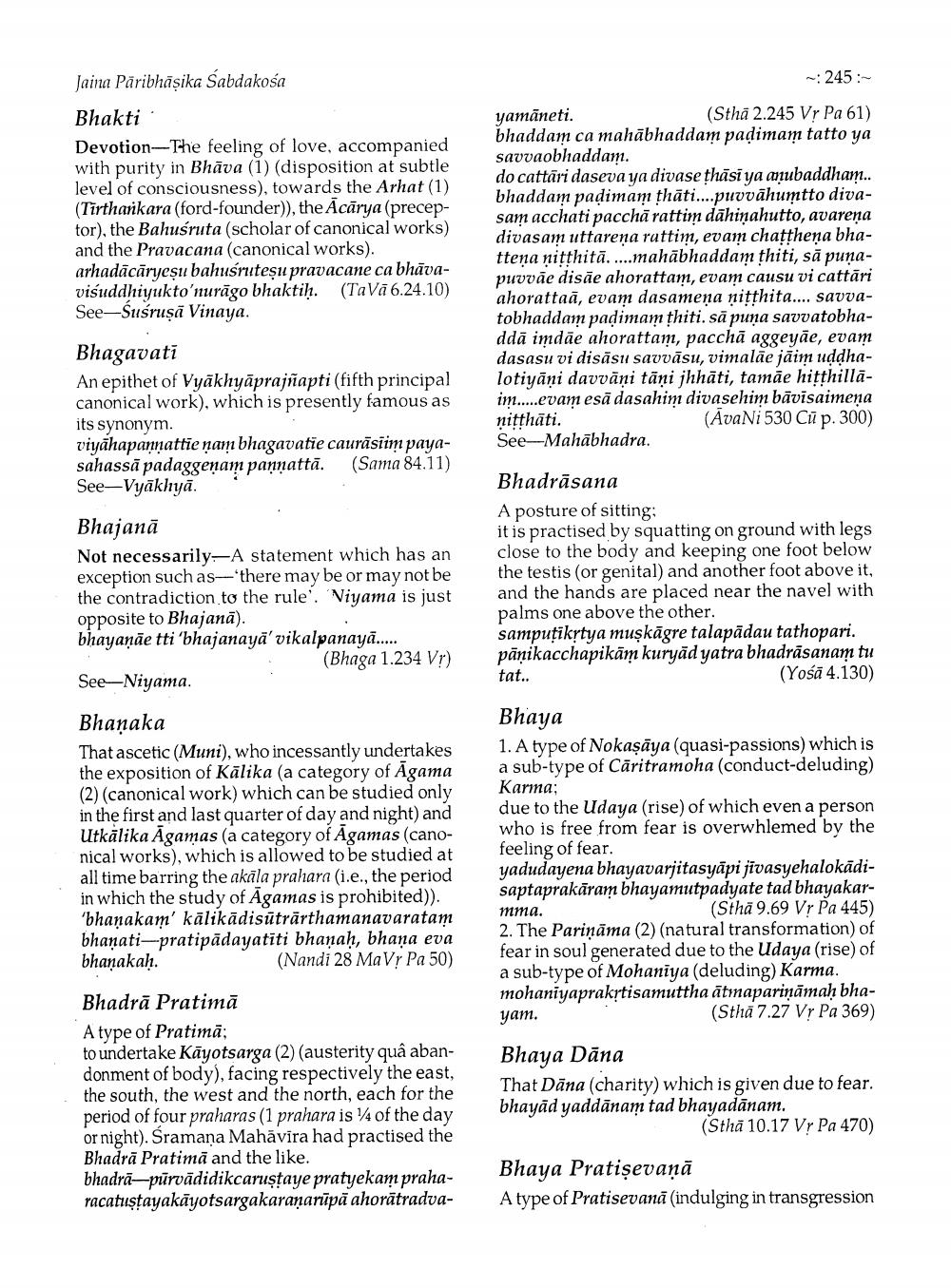________________
Jaina Paribhasika Sabdakosa
Bhakti
Devotion-The feeling of love, accompanied with purity in Bhava (1) (disposition at subtle level of consciousness), towards the Arhat (1) (Tirthankara (ford-founder)), the Acarya (preceptor), the Bahuśruta (scholar of canonical works) and the Pravacana (canonical works). arhadācāryesu bahuśrutesu pravacane ca bhāvavisuddhiyukto'murago bhaktih. (TaVa 6.24.10) See-Suśrusa Vinaya.
Bhagavati
An epithet of Vyakhyāprajñapti (fifth principal canonical work), which is presently famous as its synonym.
viyahapannattic nam bhagavatie cauräsiim payasahassa padaggenam pannatta. (Sama 84.11) See-Vyakhya.
Bhajanā
Not necessarily-A statement which has an exception such as-there may be or may not be the contradiction to the rule'. Niyama is just opposite to Bhajana).
bhayanae tti bhajanaya' vikalpanaya...... (Bhaga 1.234 Vr)
See-Niyama.
Bhaṇaka
That ascetic (Muni), who incessantly undertakes the exposition of Kalika (a category of Agama (2) (canonical work) which can be studied only in the first and last quarter of day and night) and Utkalika Agamas (a category of Agamas (canonical works), which is allowed to be studied at all time barring the akala prahara (ie., the period in which the study of Agamas is prohibited)). 'bhanakam' kälikädisüträrthamanavaratam bhanati-pratipadayatiti bhaṇaḥ, bhana eva (Nandi 28 MaVr Pa 50)
bhanakah.
Bhadra Pratimā A type of Pratima;
to undertake Kayotsarga (2) (austerity quâ abandonment of body), facing respectively the east, the south, the west and the north, each for the period of four praharas (1 prahara is % of the day or night). Sramana Mahavira had practised the Bhadra Pratima and the like. bhadra-purvādidikcarustaye pratyekam praharacatıştayakayotsargakaraṇaripa ahoratradva
~: 245~
yamaneti. (Stha 2.245 Vr Pa 61) bhaddam ca mahabhaddam padimam tatto ya savvaobhaddam.
do cattari daseva ya divase thasi ya abaddham... bhaddam padimam thäti....puvvähintto divasam acchati paccha rattim dahinahutto, avarena divasam uttarena rattim, evam chatthena bhattena nitṭhita.....mahabhaddam thiti, să puṇapuvvãe disãe ahorattam, evam causu vi cattări ahorattaa, evam dasamena niṭṭhita.... savvatobhaddam padiman thiti. sä puna savvatobhadda imdae ahorattam, paccha aggeyãe, evam dasasu vi disāsu savvāsu, vimalae jāim uddhalotiyani davväni täni jhhāti, tamäe hiṭṭhilläim.....evam esa dasahin divasehim bävisaimena nitthäti. (AvaNi 530 Ci p. 300)
See-Mahabhadra.
Bhadrasana
A posture of sitting;
it is practised by squatting on ground with legs. close to the body and keeping one foot below the testis (or genital) and another foot above it, and the hands are placed near the navel with palms one above the other. samputikṛtya muskägre talapadau tathopari. pänikacchapikām kuryād yatra bhadrasanam tu (Yosa 4.130)
tat..
Bhaya
1. A type of Nokaşaya (quasi-passions) which is a sub-type of Caritramoha (conduct-deluding) Karma:
due to the Udaya (rise) of which even a person who is free from fear is overwhlemed by the feeling of fear.
mma.
yadudayena bhayavarjitasyāpi jivasyehalokádisaptaprakaram bhayamutpadyate tad bhayakar(Stha 9.69 Vr Pa 445) 2. The Parinama (2) (natural transformation) of fear in soul generated due to the Udaya (rise) of a sub-type of Mohaniya (deluding) Karma. mohaniyaprakṛtisamuttha atmapariņāmah bha(Stha 7.27 Vr Pa 369)
yam.
Bhaya Dana
That Dana (charity) which is given due to fear. bhayad yaddanam tad bhayadānam.
(Stha 10.17 Vṛ Pa 470)
Bhaya Pratiṣevaṇā
A type of Pratisevană (indulging in transgression




